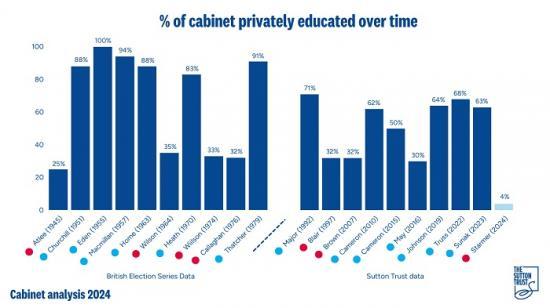What A House Of Commons With Fewer Privately Educated MPs Could Mean For The UK
12th July 2024

Elected leaders and representatives across democracies tend to be old, wealthy, male and belong to the ethnic majority of their respective countries. This lack of diversity is a problem: it suggests that those who govern are out of step with the broader society that they seek to represent.
But following the UK general election, parliament is becoming more like the electorate. A record-breaking 335 new MPs have entered the House of Commons. This dramatic change of personnel has ushered in a parliament that looks very different.
There are more women and more people from minority ethnic backgrounds in the Commons than ever before. Now, 14% of MPs have an ethnic minority background, compared to 18% in the general population. The proportion of women in the Commons now stands at 40%.
The educational backgrounds of these MPs are different, too. A report by the Sutton Trust, an educational charity, found that 23% of MPs in the new parliament were privately educated - the lowest proportion on record - while 63% attended a state comprehensive. This is an improvement from the makeup of the Commons after the last general election in 2019, when only 54% went to a comprehensive school.
In the UK, currently, 88% of pupils attend a comprehensive, and just 7% attend a private fee-paying school.
The best-represented school in Keir Starmer's cabinet is a comprehensive in Manchester: Parrs Wood High School, attended by culture secretary Lisa Nandy and leader of the House of Commons Lucy Powell.
Only one member of the new cabinet was privately educated. In contrast, two-thirds of the cabinet ministers in Rishi Sunak's government went to private schools.
Increased diversity in educational background is an important indicator of the socioeconomic status of the UK's new MPs. This shift suggests that as well as becoming more representative in terms of gender and ethnic background, the House of Commons is inching closer to accurately mirroring those they govern in terms of class as well.
Making choices
These changes to the makeup of parliament could profoundly affect politics and policymaking in the UK. Research has found that MPs from working-class backgrounds are more likely to act in the interest of the working class.
During the Labour government led by Tony Blair, MPs who had previously had working-class occupations were more likely to express concern over welfare reforms that reduced the generosity of payments and introduced conditions for means testing benefits.
They were also more likely to rebel against their party when voting on these measures. These are clear signs that the socioeconomic backgrounds of MPs play an integral part in their policy preference and behaviour once in office.
However, research published in 2023 showed that, among OECD countries, only around 5% of legislators in national parliaments had primarily worked in working-class occupations. Among the people they govern, people in working-class occupations make up around 60% of the workforce. There is a huge gap in representation for those with lower socioeconomic status.
The research found huge variations between countries. Parliaments in Nordic countries, such as Denmark and Sweden, led the way in representing the working class. In both countries, around 18% of legislators had this background. Britain was in the middle of the pack, with 5% of MPs from working-class professions.
It is also remarkable that declining representation of working-class professions is a rather recent phenomenon in the UK. It is mostly driven by a decline in the proportion of Labour MPs with working-class occupational backgrounds. This dropped from just under 30% in the late 80s to a mere 8% in the 2010-15 parliament.
The majority of the new cabinet attended comprehensive schools, making this the most representative cabinet - in terms of education backgrounds - ever recorded.
92% of the cabinet attended comprehensive schools, 4% attended grammar schools and 4% attended independent schools.
Gaps remain
While the results of the election may have shifted this a little, there is still a significant gap between the Commons and the electorate. For instance, 90% of current MPs attended university, compared to under 20% of the UK's working-age population. And while valuable efforts have been made to encourage women and people from ethnic minority backgrounds into politics, class has been largely overlooked.
The absence of the voices of those with lower socioeconomic status in democratic institutions can lead to a general sense that the people in power do not represent or respond to the needs of the majority of those they govern. This may in turn fuel the rise of populist parties, both on the right and left of politics, across developed democracies.
The increased educational diversity among MPs is a welcome sign that parliament has become more representative of the UK and should be seen as an important step in enhancing the voices of those from less privileged backgrounds in Westminster. It could lead to more responsive policymaking as well as enhance the legitimacy of the Commons as a democratic institution. However, there is still a lot more room for improvement.
Author
Wang Leung (Kiwi) Ting
Lecturer in Comparative Politics, University of Reading
Note
This article is from The Conversation web site. To read it with links to more information go HERE
